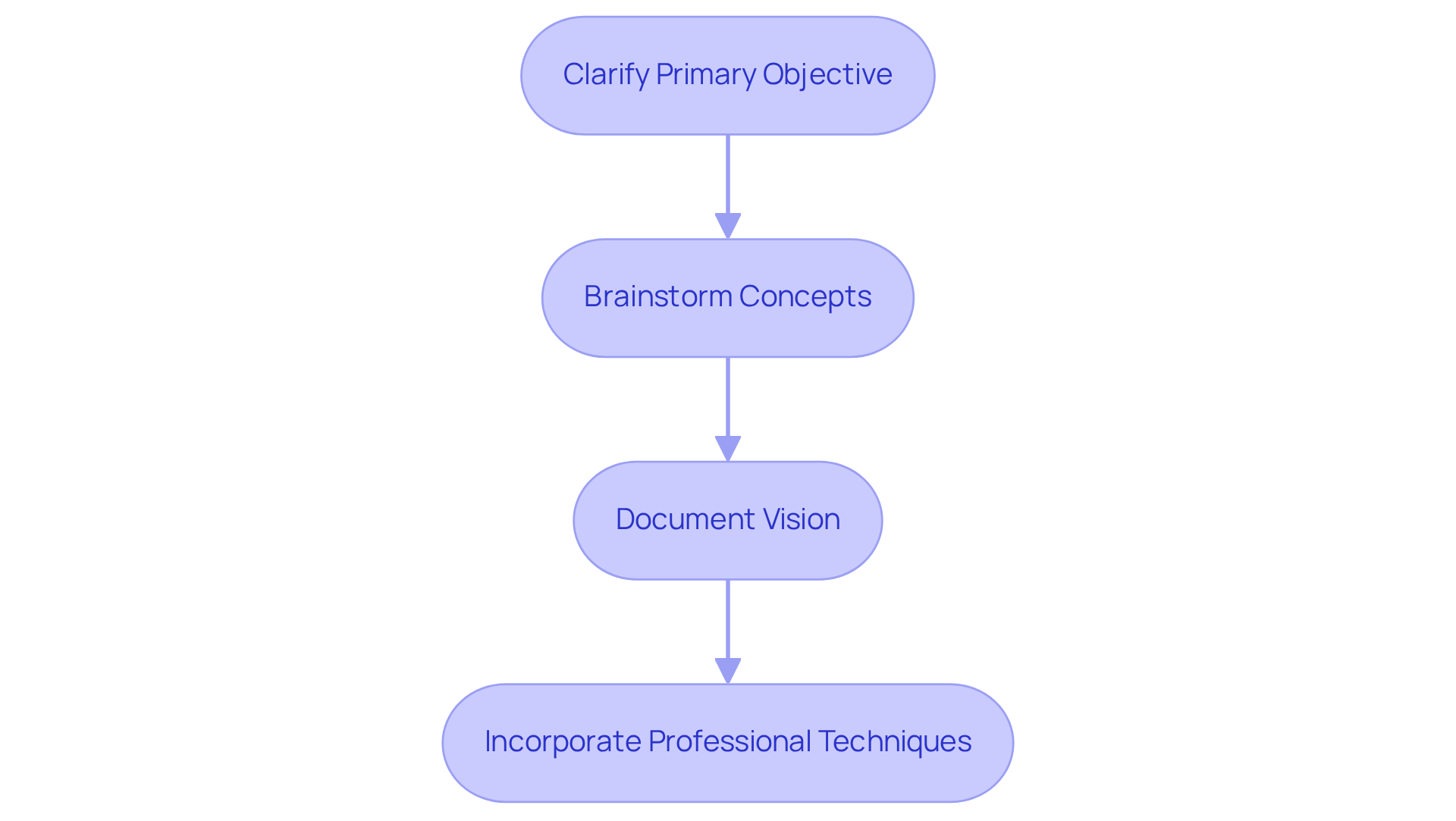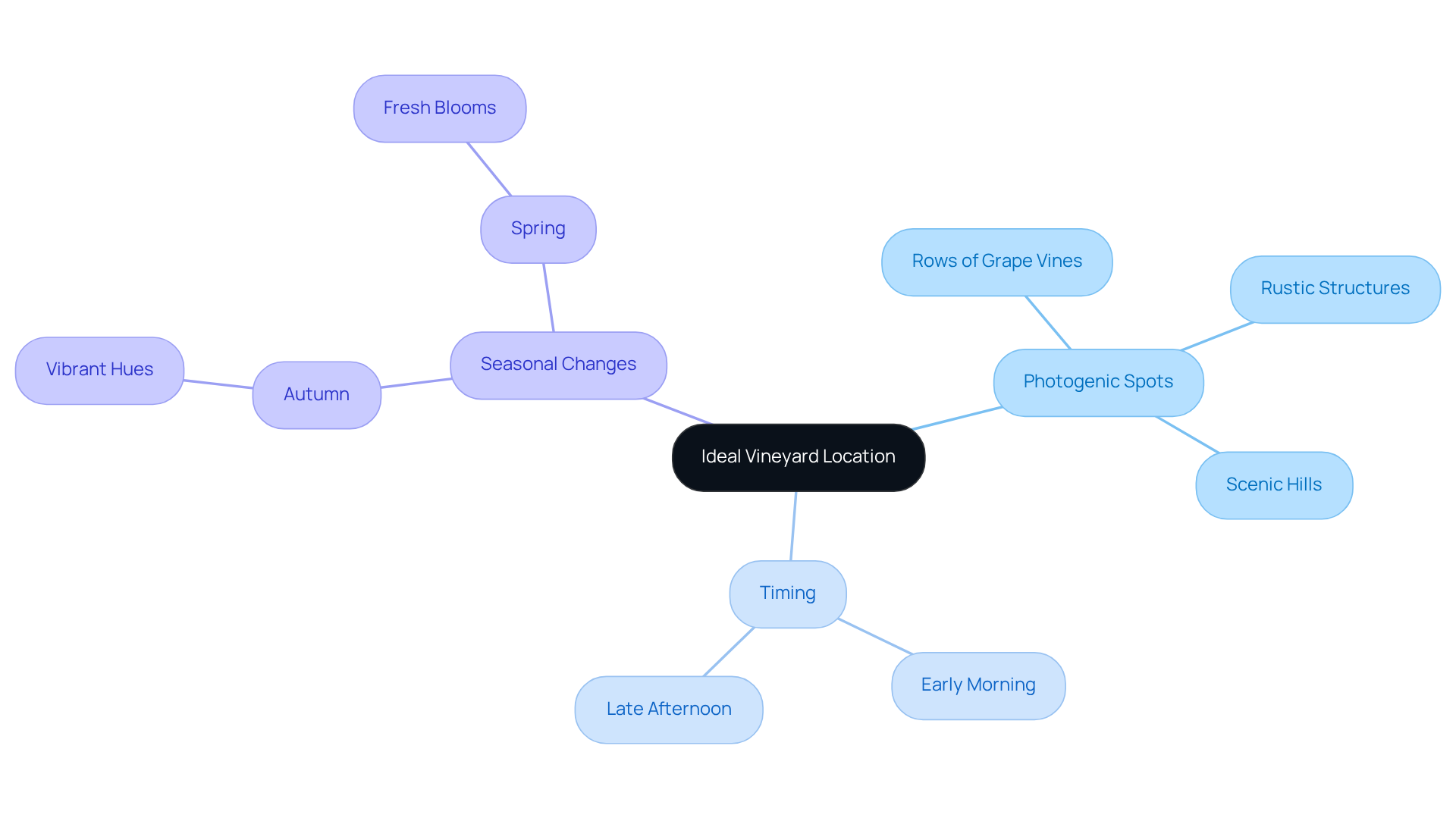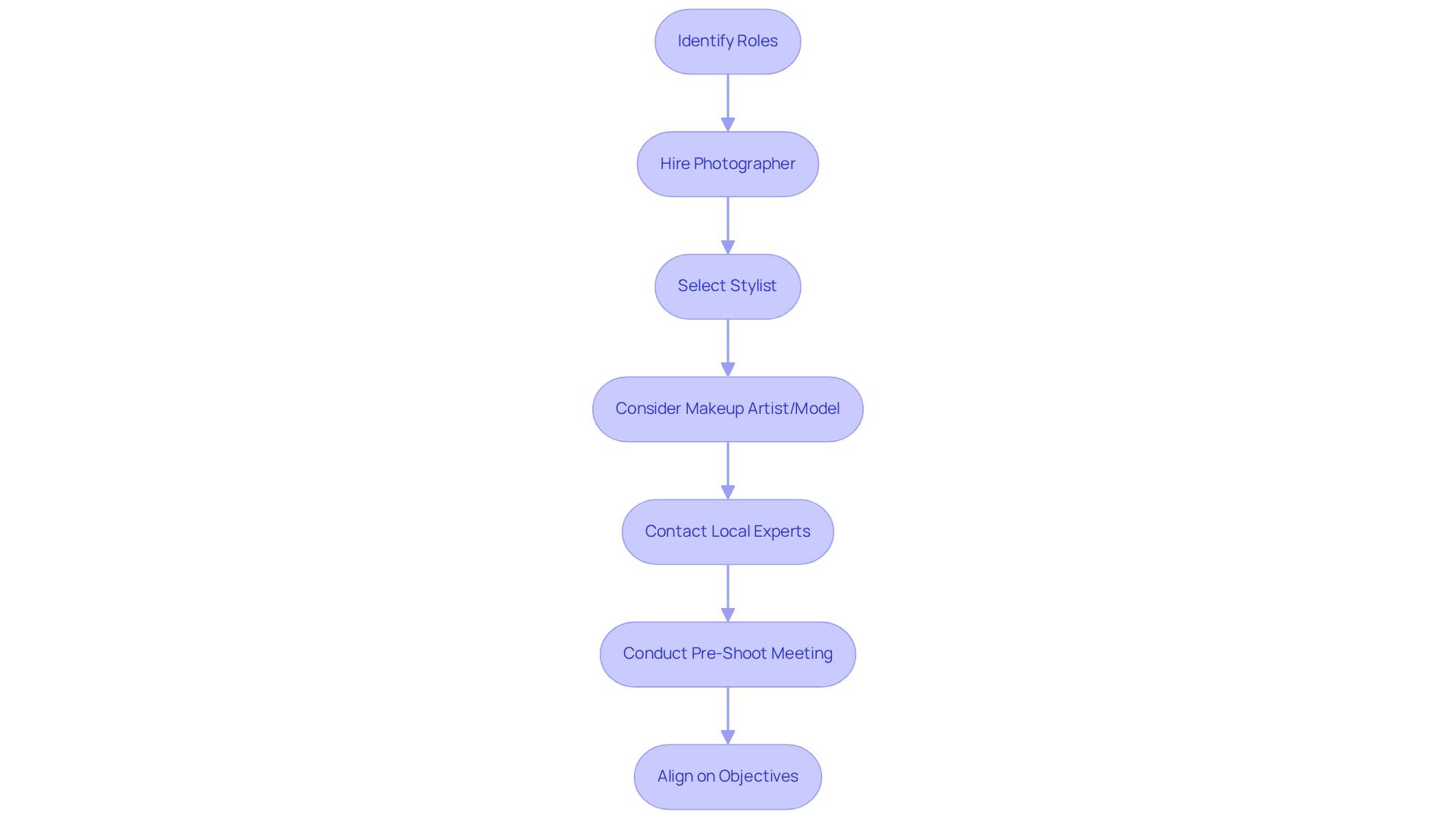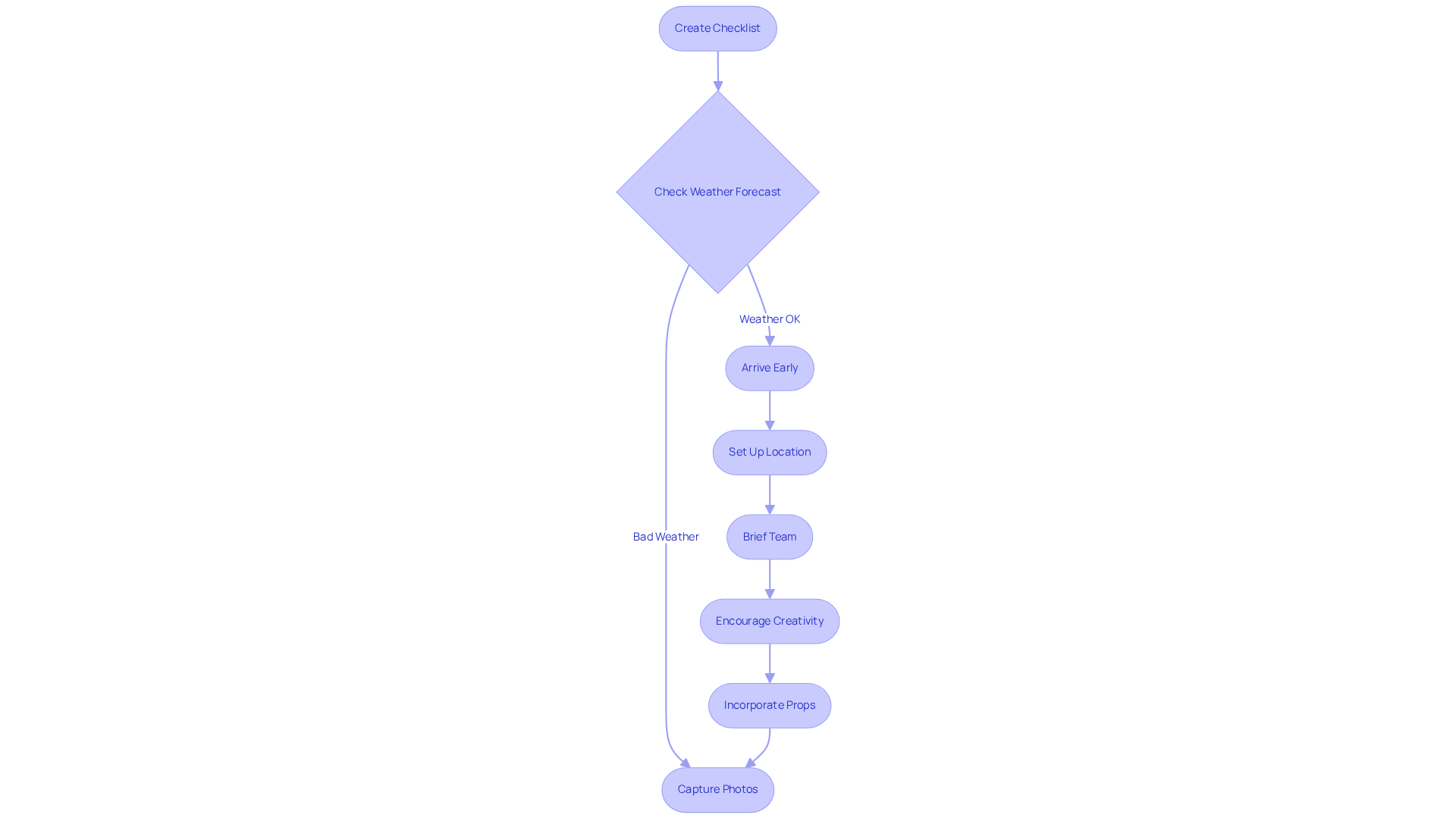Overview
This article delineates four essential steps for mastering a vineyard photoshoot:
- Defining objectives
- Choosing the ideal location
- Assembling a capable team
- Preparing for the shoot day
Each step underscores the necessity of clarity in vision, strategic location selection, teamwork, and meticulous preparation. These elements are crucial for creating visually compelling images that resonate with the brand's identity and effectively engage consumers. By embracing these principles, professionals in the wine industry can elevate their marketing efforts and enhance their connection with their audience.
Introduction
Capturing the essence of a vineyard through photography is an art form that demands meticulous planning and execution. A successful vineyard photoshoot not only highlights the breathtaking beauty of the landscape but also weaves a compelling narrative that resonates with potential customers. As competition in the wine industry escalates, the question arises: how can vineyards effectively set themselves apart through visual storytelling? This guide delves into four essential steps that will empower vineyard owners to master their photoshoots, ensuring that every image embodies their unique brand identity and engages consumers on a deeper level.
Define Your Photoshoot Objectives and Vision
Begin by clarifying the primary objective of your photoshoot. Are you aiming to develop marketing materials, create engaging social media content, or tell a visual story for your website? Establishing a clear objective is essential for enhancing your establishment's direct-to-consumer strategies.
Next, brainstorm concepts that resonate with your brand's identity and the compelling narrative you wish to convey. Consider the emotions you want to evoke and the message you aim to communicate. Document your vision in a concise statement, which will serve as a guiding principle throughout the planning process.
For instance, if your goal is to showcase the rustic appeal of your estate, your vision might be:
'To capture the warmth and authenticity of our family-owned property through golden hour imagery that emphasizes our distinctive terroir.'
This focused approach not only enhances the quality of your imagery but also significantly boosts by creating a relatable and compelling narrative that fosters loyalty among casual buyers.
Furthermore, incorporating professional imaging techniques, such as utilizing natural light and lifestyle shots, can elevate your winery's online presence and attract more customers. In today's digital landscape, high-quality images are crucial, as they significantly increase consumer interest and engagement, ultimately driving predictable DTC revenue.

Choose the Ideal Vineyard Location
To capture stunning vineyard photoshoot images, it is essential to evaluate various areas of your vineyard to identify the most . Seek locations that offer a diverse range of backdrops, such as:
- Rows of grapevines
- Rustic structures
- Scenic hills
As Yusra Bintemohiuddin asserts, "Vineyards must differentiate through unique offerings and creative campaigns to avoid competing solely on price," highlighting the significance of selecting visually captivating locations that convey a narrative.
Timing plays a crucial role; early morning or late afternoon typically provides the best natural light for photography. Furthermore, consider how seasonal changes affect the visual allure of the wine estate. For instance:
- Autumn presents vibrant hues
- Spring showcases fresh blooms
Successful vineyard photoshoot sites, such as Castello di Amorosa, provide breathtaking settings that enhance marketing initiatives. After identifying potential locations, visit them at different times to observe the shifting light and to effectively visualize your shots.

Assemble Your Photoshoot Team
To achieve a in a grape-growing area, assembling a well-rounded team is essential. Key roles typically include a photographer, stylist, and potentially a makeup artist or model, depending on your creative vision. Hiring an experienced photographer who specializes in vineyard or outdoor settings is crucial, as they possess the expertise to effectively utilize natural light and capture the landscape's beauty.
As noted by Highway 29 Creative, 'Planning a photo shoot is more than just a to-do list. It’s a chance to share with the world who you are, why your establishment matters, and why your customers should care.' Statistics indicate that collaborative efforts in marketing shoots can enhance the overall quality and effectiveness of the visuals, making it vital to select team members who can work seamlessly together. Done right, your photos become more than images—they become connection points between your brand and the people who love it.
Consider contacting local experts or seeking suggestions from other vineyards to find the right fit. Once your team is established, conduct a pre-shoot meeting to align on objectives, share your vision statement, and outline a detailed shot list. This preparation ensures that everyone understands their roles and contributes to a cohesive and impactful photoshoot. Remember to treat your vineyard as a canvas to convey your establishment's story, highlighting aspects like sustainability or romance.

Prepare for the Photoshoot Day
To ensure a successful vineyard photoshoot, it is essential to create a detailed checklist that encompasses all necessary equipment, props, and permits. Verify the weather forecast in advance; research indicates that can significantly impact outdoor imaging results. For example, overcast days offer soft, diffused lighting, while bright sunlight can cast harsh shadows. Statistics show that morning or evening light yields the best results for capturing vineyard photoshoot. Always have a backup plan for inclement weather, such as indoor venues or alternative shooting dates.
On the day of the shoot, arrive early to set up and ensure the location is clean and free of distractions. Brief your team on the schedule and the specific shots you wish to capture, while also encouraging creativity and flexibility. Some of the most captivating images emerge from spontaneous moments, so be prepared to adapt to the environment.
As Frank Gutierrez, a commercial photographer, emphasizes, "Working together to make a photo set that proudly represents your brand should be the goal of every photographic partnership." This mindset aids in staying organized and focused throughout the day. Additionally, consider incorporating props like wine glasses to enhance the visual storytelling of your images. Finally, remember to enjoy the process; a positive atmosphere will reflect in the final images, bringing your winery's story to life.

Conclusion
Mastering a vineyard photoshoot demands a strategic approach, beginning with a clear definition of objectives and a compelling vision that aligns with the brand's identity. Establishing these foundational elements allows the photoshoot to effectively communicate the unique story of the vineyard, enhancing consumer engagement and driving direct-to-consumer revenue.
Insights from the article highlight the critical importance of:
- Selecting the right location
- Assembling a skilled team
- Thorough preparation for the shoot day
Choosing photogenic spots that reflect the vineyard's character, collaborating with talented professionals, and being well-prepared for varying weather conditions all contribute to capturing stunning imagery that resonates with audiences. Each step—from planning to execution—plays a vital role in creating visuals that not only attract but also connect with potential customers.
In conclusion, the art of vineyard photography transcends mere image capture; it is about crafting a narrative that embodies the essence of the establishment. By adhering to these steps, vineyards can create captivating visual content that not only showcases their beauty but also fosters a deeper connection with their audience. Embrace the opportunity to narrate your vineyard's story through photography, and witness how it transforms your marketing efforts and strengthens customer loyalty.
Frequently Asked Questions
What is the first step in planning a photoshoot?
The first step is to clarify the primary objective of your photoshoot, such as developing marketing materials, creating social media content, or telling a visual story for your website.
Why is it important to establish a clear objective for a photoshoot?
Establishing a clear objective is essential for enhancing your establishment's direct-to-consumer strategies and ensuring that the photoshoot aligns with your brand's goals.
How can I brainstorm concepts for my photoshoot?
You can brainstorm concepts by considering your brand's identity, the compelling narrative you wish to convey, the emotions you want to evoke, and the message you aim to communicate.
What should I do with my vision for the photoshoot?
Document your vision in a concise statement, which will serve as a guiding principle throughout the planning process.
Can you provide an example of a photoshoot vision statement?
An example of a photoshoot vision statement is: "To capture the warmth and authenticity of our family-owned property through golden hour imagery that emphasizes our distinctive terroir."
How does a focused approach to photoshoots benefit consumer engagement?
A focused approach enhances the quality of your imagery and boosts consumer engagement by creating a relatable and compelling narrative that fosters loyalty among casual buyers.
What professional imaging techniques can improve a winery's online presence?
Incorporating professional imaging techniques such as utilizing natural light and lifestyle shots can elevate a winery's online presence and attract more customers.
Why are high-quality images important in today's digital landscape?
High-quality images are crucial because they significantly increase consumer interest and engagement, ultimately driving predictable direct-to-consumer revenue.




